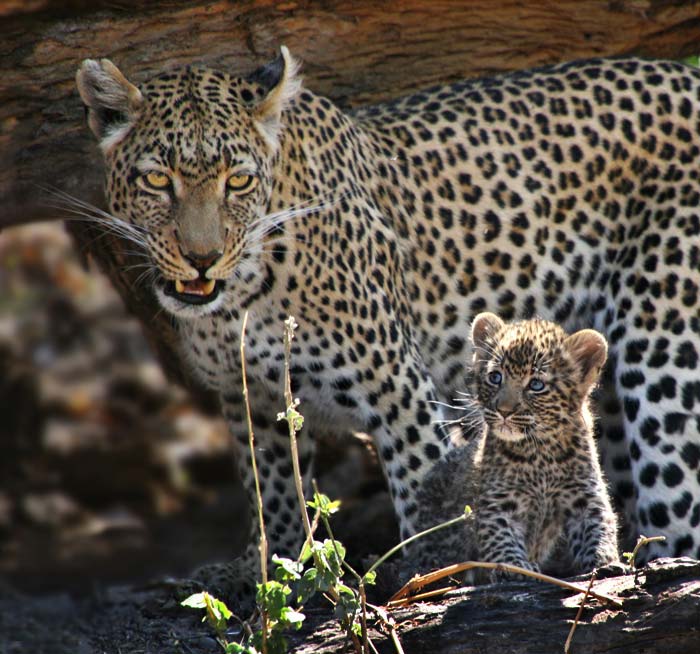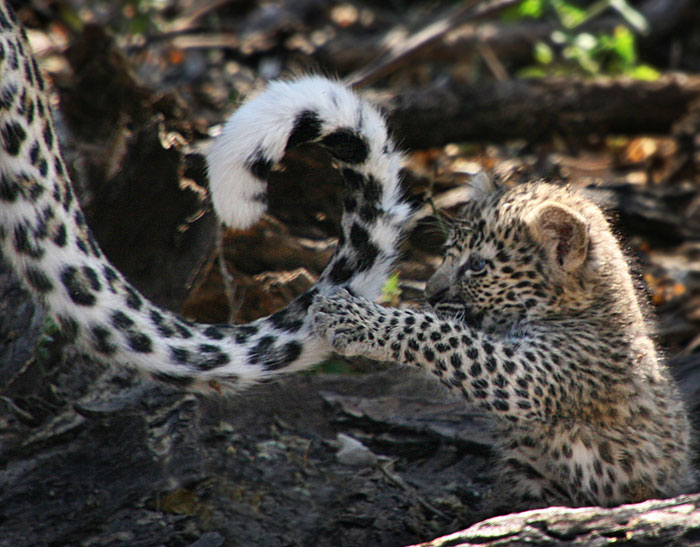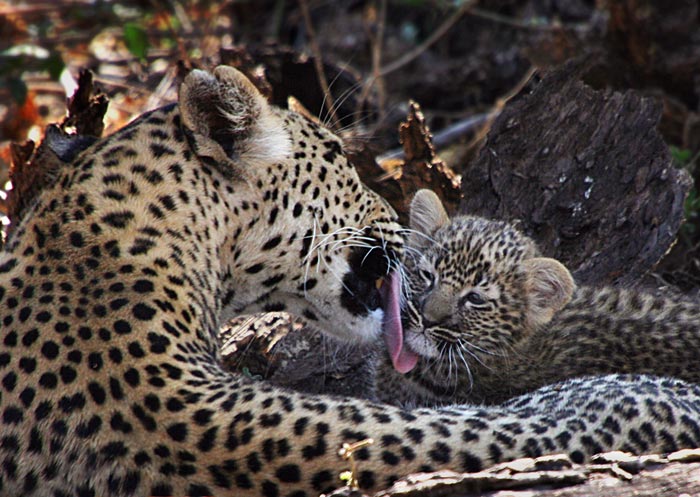
© 2011 Jenny Sheldon Kirk. All rights reserved.
Wildlife photography while in the field is exciting, but it can also be very challenging. You can have incredible opportunities, but because you do not have control over the animals, the light or backgrounds, composition can prove to be a difficult task. In addition, if you are with a guided tour group, you don’t always have the freedom to move around in order to get a better angle. But, no matter what photo obstacles lie in your path, you’ll want to seize the moment and enjoy the adventure.
Being prepared for almost anything to happen and knowing your camera’s functions and the options available are the key factors needed to capturing unforgettable moments.
Amateur photographer, Jenny Sheldon Kirk, shares her safari experience and the way she handled some challenging photographic choices.
Three Moments in Time by Jenny Sheldon Kirk
Subject: Leopard mother and cubs while on safari at the Moremi Game Reserve in Botswana, Africa
Conditions: Jenny spoke about this special opportunity. “It was during one of my and my husband’s game runs that we came upon this mother leopard. She had “stashed” her 1 week to ten-day- old twin cubs under a fallen log that was near an overflow area near the river. They still had their baby blue eyes. We sat and observed then for a while until mom relaxed and then the curious little cubs came out to see us too. Soon all ignored our presence and went about their daily lives.”
Composition–Lead Image Above:
1. Your attention is pulled to their faces by the brilliant color of their eyes.
2. The weeds in the foreground lead you to both the mother’s face and the baby keeping you trapped in the implied triangle.
3. The contrast of light on the subjects adds interest. The mother’s large size and darker exposure grabs you attention first and then your eye is drawn down to the ribbon of light around the cub.
Composition–Image 2:

© 2011 Jenny Sheldon Kirk. All rights reserved.
1. The strong diagonal line between the baby and the tail of the mother pulls your eye across the image and adds a sense of motion.
2. Sunlight on the cub’s fur makes every hair on its back stand out.
3. The texture of the fur plus the contrast between baby spots and adult spots adds interest to this action shot.
4. Because the tail is curled it pulls the eye continuously back to the subject and away from a busy background.
Composition–Image 3:

© 2011 Jenny Sheldon Kirk. All rights reserved.
1. Soft light under the shade of the tree compliments the lovely moment between mother and cub.
2. The implied oval shape of mother and cub keeps bringing your eyes around and focused on the baby and the action of the mother.
3. Careful selection of the depth of field allowed a distracting background of tangled leaves and branches to soften and blur and this served the purpose of separating the animals from the background.
Noella’s comments:
Whenever you are photographing wildlife in the field, whether on safari or in your own backyard, you need to be looking for those special moments when the animal’s behavior is unique. Sometimes it is a simple action and other times it is a look or a glance that makes the image stand out. Portraits are wonderful and should be taken, but animal behavior is the key to unusual and stunning images.
Seeing a leopard in the wild is very rare and to have the opportunity to observe a mother with cubs is even more remarkable. In the image of the mother and cub looking at the camera, it is the eyes that fascinate–the intensity of the stare. The decision being made by the mother might have been … do I trust, defend the cubs or charge the intruders? Jenny has captured a breath-taking moment.
All of the images had rather distracting backgrounds which included strong contrasting light. Therefore, you will need to make exposure and depth of field decisions. Typically, when you are faced with a very busy background which can’t be changed, adjusting your f-stop or aperture to blur the background is helpful.
Jenny chose to work on the behavior of the animals and watch for the small little things that made this opportunity so special, such as when Mom settled down to lick the cub. Obviously in this instance, the mother leopard is relaxed, but it is also important that you as a photographer pay attention to your own body language. By remaining calm, quiet and collected, your animal subject will more than likely do the same, allowing you to capture some extraordinary images.
In the old film days when someone would ask, “What are the best camera settings to use?” we used to say, “F-8 and being there.” Being prepared is part of the photographic experience because you never know when an exceptional opportunity will come your way. You made some wonderful choices and did a great job Jenny!
Come back and join us for another IMAGE TALK in the near future.
Acknowledgments: I would like to thank Marla Meier for her editing assistance in order to present the images for this series. And, our thanks to the photographer/artists who allow us the use of their wonderful photos in these columns.

Leave a Reply